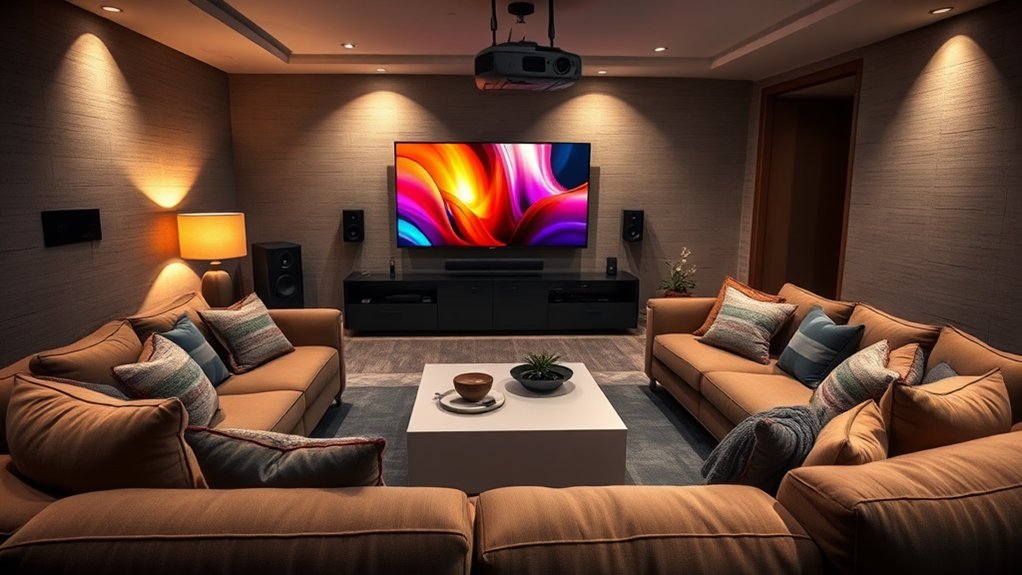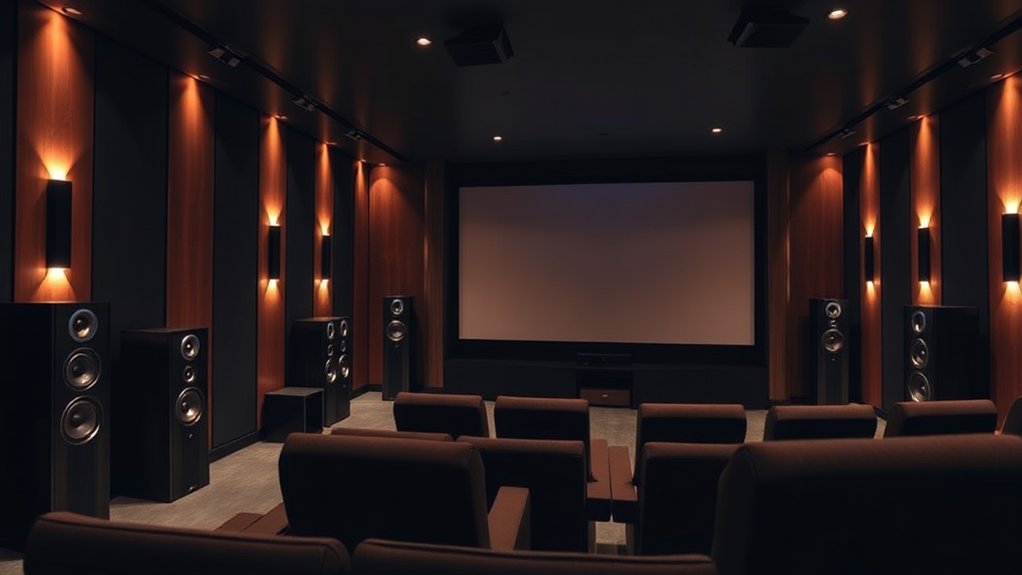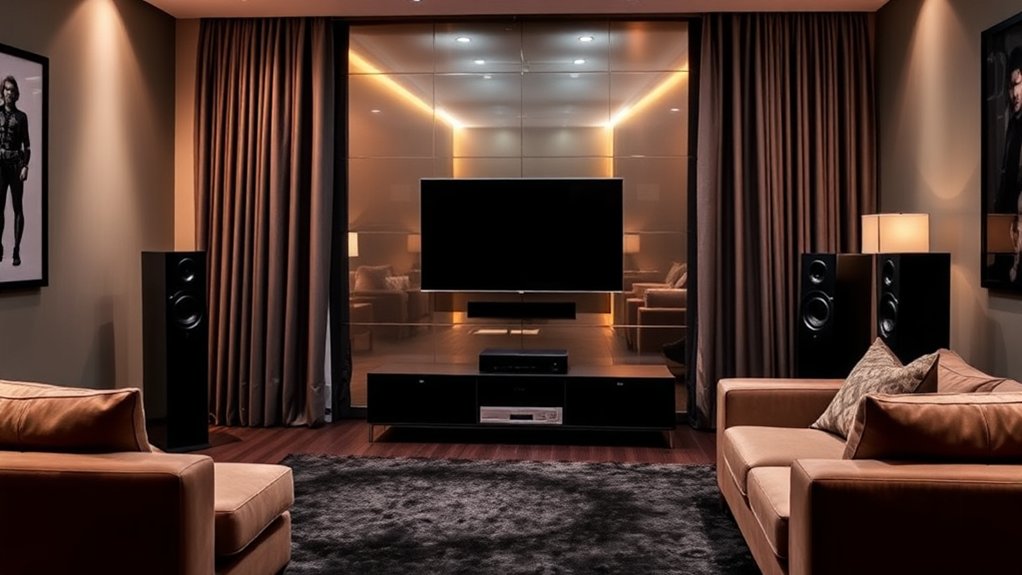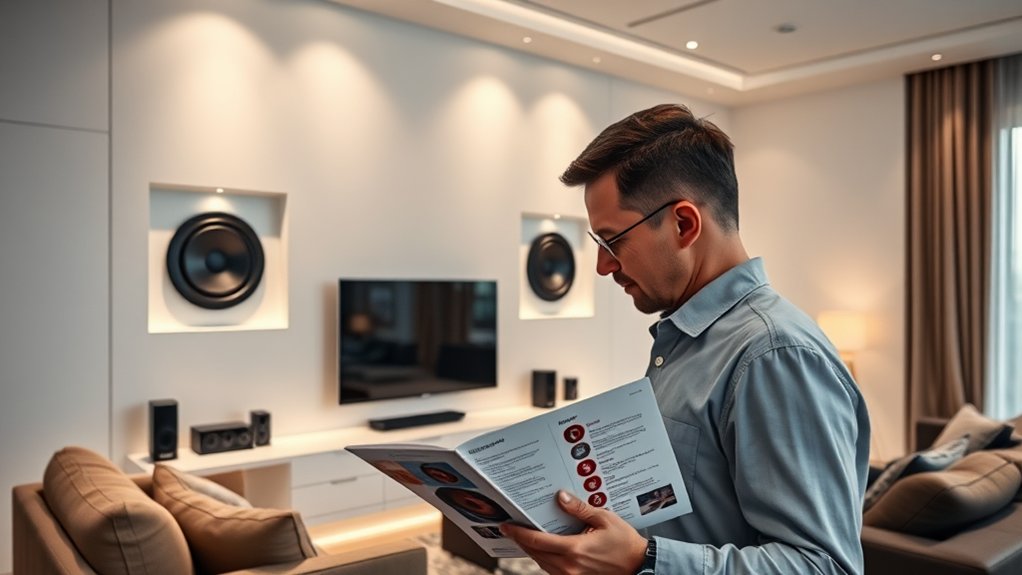Creating an affordable home theater surround sound setup is easier than you think! Start with budget-friendly gear like Q Acoustics or Vizio speakers to get great sound without breaking the bank. Position your speakers strategically—think 25-30 degrees for front speakers and 135-150 for surrounds—to amplify your experience. Don’t forget your subwoofer; it’s the secret sauce for bass that brings action to life. Want to know more tips and tricks for an immersive setup? Stick around!
Key Highlights
- Choose budget-friendly equipment like the VIZIO V51x-J6 for improved audio without high costs.
- Strategically place speakers at recommended angles for optimal sound experience and clarity.
- Opt for a quality 5.1 surround sound configuration to balance performance and budget constraints.
- Invest in a capable subwoofer to enhance low-frequency sounds for immersive viewing.
- Plan gradual upgrades to the sound system, focusing on essential components first.
Choosing Budget-Friendly Equipment
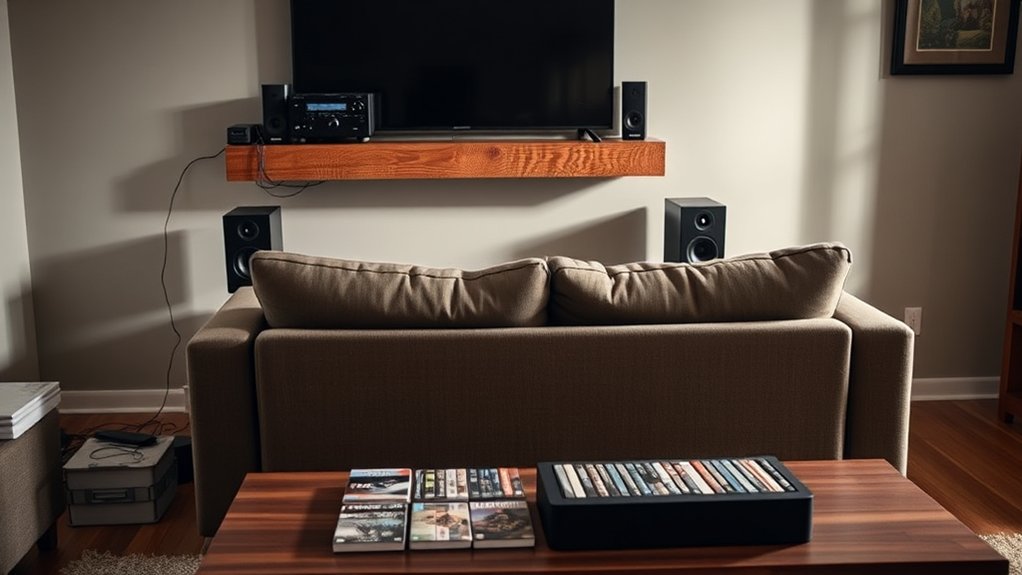
When you’re diving into the world of home theater audio, it can feel a bit overwhelming, especially if you’re trying to stick to a budget. You want quality sound without breaking the bank, right?
Start by investigating award-winning packages like the Q Acoustics 5040, which balances price with performance. If space is an issue, options like the Sonos Arc soundbar offer surround capabilities as they remain sleek and unobtrusive. The VIZIO V51x-J6 is also a solid choice, providing a notable improvement over built-in TV speakers at an affordable price.
Remember, focusing your budget on key components—like front left, center, and right speakers—guarantees dialogue clarity during your movie marathons. Additionally, consider investing in affordable speaker packages that provide impressive audio quality without stretching your finances. For optimal performance, ensure your room size aligns with your equipment choices to avoid sound distortion.
Whether you opt for bundles or individual pieces, make certain your selections fit your room without cramping your style. After all, the best equipment should improve your experience, not overcrowd your living space!
Strategic Speaker Placement
Strategic speaker placement is crucial for crafting an immersive audio experience, and getting it right can make all the difference in your home theater setup.
Start by positioning your front left and right speakers at a 25-30 degree angle from your favorite seat—this improves stereo imaging and separation. The center channel should be directly in front, ideally at ear level, for crystal-clear dialogue; any obstacles here are like inviting charades to your movie night. To enhance effects, place your rear surround speakers at 135-150 degrees off-axis from your seating position for a more enveloping experience. Proper speaker placement ensures that sound quality is maximized, leading to a more rewarding audio immersion. Make sure to prioritize spatial dimensions and acoustics to achieve optimal sound distribution, as these are essential for creating immersive audio experiences.
Position your front speakers at a 25-30 degree angle for enhanced stereo imaging and ensure the center channel is at ear level for clear dialogue.
Surround speakers should flank your seat at 90-110 degrees off-axis, ensuring the sound surrounds you, not just infiltrates your space. Remember to experiment and adjust placement; sometimes a small shift can unlock immense potential in sound quality.
Why settle for anything less than spectacular sound, right?
System Configuration and Calibration

Setting up a surround sound system isn’t just about picking a model off the shelf; it’s an art that combines science and a bit of finesse.
First, decide between configurations like 5.1, 7.1, or even 9.1, based on your room size and budget. A 5.1 setup is perfect for beginners, whereas 7.1 offers more depth, providing an immersive audio experience compared to simpler setups.
You’ll want to make certain your speakers are securely connected to avoid any silent gaps. Once set up, calibrate the speaker levels so sound reaches you evenly from all directions—otherwise, who wants to miss that vital dialogue, right?
Room calibration software simplifies adjustments, but manual tweaks can yield better results, guaranteeing that your audio experience is exceptional—because, let’s face it, no one enjoys muddy sound! Furthermore, utilizing a surround sound receiver can greatly enhance the precision with which audio is directed to your speakers.
The Importance of the Subwoofer
Though you’ve taken the time to configure and calibrate your surround sound system, there’s one element that can truly improve your home theater experience: the subwoofer. This powerhouse reproduces low frequencies that standard speakers often struggle with, filling a crucial audio gap.
Imagine the heart-thumping excitement of an explosion or the deep thrum of a bass line—these sounds add emotional weight to your movies and music. By offloading these bass duties, subwoofers allow your other speakers to focus on crisp midrange and treble frequencies, enhancing clarity and reducing distortion.
Plus, good placement can help create an immersive sound environment that makes you feel like you’re part of the action. Have you ever really “felt” a movie? That’s the magic of a quality subwoofer.
Cost-Effective Upgrade Tips
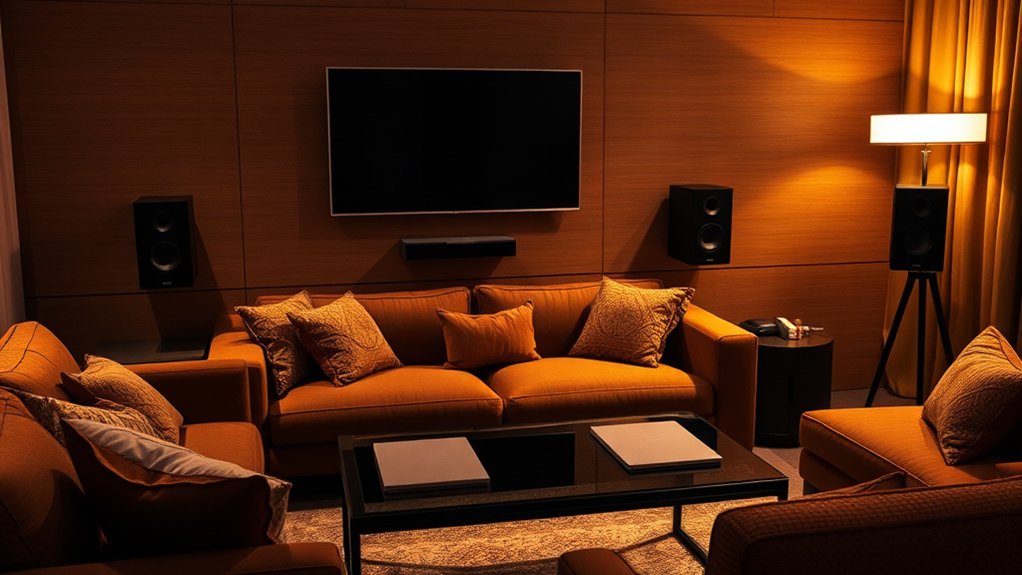
When you’re ready to improve your home theater experience without blowing your budget, focusing on cost-effective upgrades can make all the difference.
First, consider investing in a quality AV receiver; it’s the backbone of your system and can greatly enhance sound quality. If money’s tight, check second-hand options online—just be certain to read reviews to avoid a clunker.
Investing in a solid AV receiver is crucial; it elevates sound quality and doesn’t have to break the bank—look for second-hand deals!
Next, grab some excellent front speakers—after all, they’ll deliver most of the sound. Vintage finds can often outperform cheaper new models, so keep that in mind.
Finally, welcome modularity; start with a 5.1 setup and gradually expand. That way, you’ll never feel pressured to replace everything at once. Isn’t that a sigh of relief? Additionally, consider the advantages of immersive surround sound provided by a soundbar setup like the JBL Bar 700 PRO, which enhances your audio experience significantly.
Room and Environment Optimization
To improve your home theater experience, understanding how to optimize your room and environment is key, not just an afterthought.
Start by positioning your subwoofers strategically; they’re not just for show! Proper placement minimizes bass modes, smoothing response across various spots. Incorporating room correction technology is like having an audio sidekick—analyzing sound frequencies and balancing your bass for a cleaner sound.
Don’t forget the corners; bass traps can absorb those annoying low-frequency reflections, and acoustic panels reduce echo, giving clarity you didn’t know you needed.
Finally, think about your speaker arrangement: angle your center channel toward you for better dialogue. After all, why should you struggle to hear when the whole point is enjoying the movie?
Incremental Upgrades for Long-Term Improvement
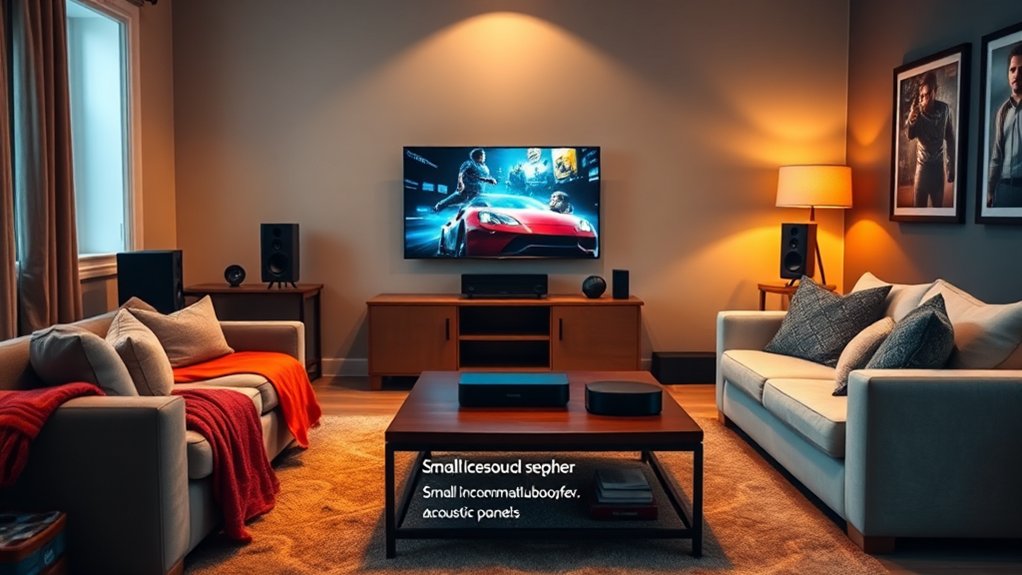
Optimizing your room sets a solid foundation for enjoying movies and music, but the adventure doesn’t end there.
Start with a high-quality core system, like a sturdy AV receiver and premium front speakers. You can easily expand from a 5.1 setup to 7.1 by adding rear surrounds or a second subwoofer. It’s like building a pizza—start with the crust and top it off gradually!
Begin with a solid AV receiver and front speakers, then layer in components like surrounds and subwoofers for a complete experience.
Regular calibration guarantees you maintain balanced sound. Tweak speaker levels and distances for that cinema-like experience at home.
Maybe later, consider wireless speakers to cut down on messy wires. By planning your upgrades, you’ll enjoy long-term improvements without breaking the bank, all during enhancing your home theater gradually, one piece at a time!
Frequently Asked Questions
What Is the Best Budget-Friendly Brand for Home Theater Receivers?
For budget-friendly home theater receivers, you’ll find Yamaha and Onkyo often topping the list. They provide excellent sound quality, reliable performance, and feature-rich options, making them great choices for your affordable setup.
How Can I Test My Surround Sound System After Setup?
To test your surround sound system after setup, use an SPL meter to calibrate volumes, play audio test tones for each channel, and check wiring connections to confirm ideal performance and sound balance throughout your speakers.
Is a Soundbar Sufficient for Home Theater Experience?
A soundbar can improve your home theater experience, but it might fall short of true immersion. If you crave cinematic audio depth and spatial accuracy, consider investing in a full surround sound system for maximum enjoyment.
Can I Use Regular Speakers for Surround Sound Setup?
Yes, you can use regular speakers for a surround sound setup, as long as they’re compatible with your system. Just make sure they match in impedance, and pay attention to placement for the best audio experience.
How Do Room Dimensions Affect Sound Quality?
Room dimensions directly affect sound quality by influencing reverberation, bass response, and clarity. Larger spaces improve immersion, whereas smaller rooms may cause distorted sound. Balancing your room’s shape helps create a more enjoyable listening experience.

